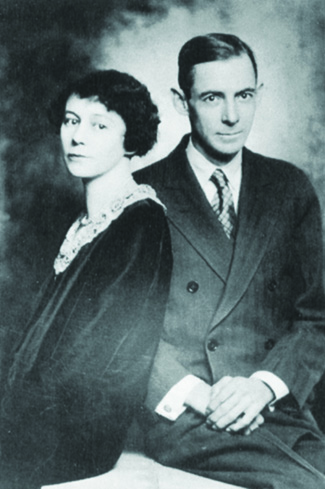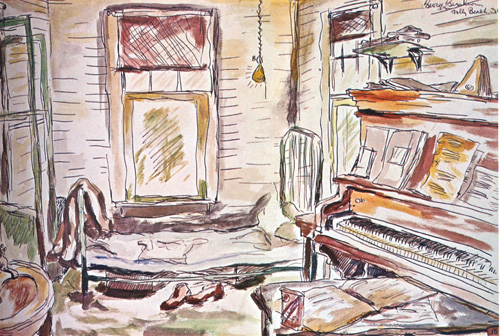
Charleston author DuBose Heyward’s Porgy was published in 1925, and its simple tale of a handicapped black peddler and the woman he loved became a bestseller. Given a copy by lyricist Emily Paley, Gershwin returned late to his apartment from a party and stayed up all night reading it. Immediately he thought it would be the perfect vehicle to create the first truly American opera. He began correspondence with Heyward, but because Gershwin was not ready to begin work on the opera immediately, the project was put aside. Heyward’s wife Dorothy, however, who had studied playwrighting, secretly began a non-musical adaptation. Later, she shared her progress with DuBose and the two of them finished adapting the novel as a stage play. This version of Porgy’s story was produced to great acclaim on Broadway by the Theatre Guild in 1927. Heyward himself coached the actors on Gullah accents, traditional Lowcountry spirituals were incorporated into the play, and the renowned Jenkins Orphanage Band was brought from Charleston to take part in the production.

The success of the play enhanced Gershwin’s interest, and in 1933 he and Heyward agreed to begin work on a full-scale opera version of Porgy. Before they could get to work, however, Gershwin, much to Heyward’s dismay, signed on to produce an NBC Radio Show entitled, Music by Gershwin which was sponsored by Fin-a-mint Laxative. Gershwin asked Heyward to be patient, explaining he needed the funds generated by the radio show to pay for the time he needed to write the opera. Though much of Gershwin and Heyward’s collaboration was done via mail with Heyward in Charleston and Gershwin in New York, Heyward insisted that Gershwin visit Charleston to absorb first hand the rich Gullah culture of the Lowcountry. Gershwin and Heyward met in Charleston to begin work on the opera during Christmas 1933, but this was only a brief visit. At Heyward’s urging, Gershwin agreed to return the following summer for a working vacation on Folly Island, where he intended to soak up the atmosphere he would need to compose Porgy and Bess.

In mid-June 1934, Gershwin arrived by train in Charleston with his cousin, the painter, Henry Botkin. Though not a character in the play, we have artist Henry Botkin to thank for the watercolor sketch of the front beach cottage that was rented for his time on Folly. Gershwin and his cousin were met at the station by Paul Mueller, Gershwin’s black valet who had driven Gershwin’s Buick down from New York to Charleston. (For the first time, Mueller is a character in the newest version of Gershwin at Folly.)

With Paul at the wheel, Gershwin traveled by car and ferry (there was no bridge) to primitive Folly Island. They even had to bring their own drinking water for there was no fresh water on Folly at the time. DuBose and Dorothy Heyward arrived home from Hollywood the next day. Heyward had been out west working on the screenplay for Pearl Buck’s The Good Earth. The Heywards stayed across the street in their beach house which they had dubbed “Follywood” since it had been purchased with Heyward’s tinsel-town royalties. This cottage, now restored, still stands on Folly. Sadly, Gershwin’s cottage washed away in the hurricane of 1938.
Getting wind of the legendary George Gershwin’s arrival on Folly Beach, enterprising young Post and Courier reporter Frank Gilbreth, Jr. (whom many Charlestonians will remember as long-time columnist Ashley Cooper and who 14 years later would co-write the bestseller, Cheaper by the Dozen) showed up to interview Gershwin at his Folly Beach cottage. On June 19, 1934, under the News and Courier, the headline “Gershwin Prince of Jazz Pounds Out Rhythm at Folly-composer here to write opera of Porgy-Finds Beach ‘Back to Nature Place’.” Gilbreth reported:
Ragtime rang out loud and clear along the deserted shore at the west end of Folly Beach and mingled with the half hearted swish of small breakers . . . seated at the piano Mr. Gershwin was playing jazz as it had never been played at Folly before . . . in the kitchen two servants tapped the floor and swayed side to side. This reporter was punching the top of the piano with his fist. It was impossible to stand still.
Two weeks later, on June 29th, 1934, Gilbreth returned to find that Gershwin had “gone native.” This time Gilbreth’s headline read: “Gershwin Gone Native, Finds It ‘Shame to Work at Folly’-Wears Only Torn Pants While Writing the Opera Porgy” and his report read:
Bare . . . above the waist, an inch of hair bristling from his face and a pair of tattered kickers furnishing a sole connecting link with civilization, George Gershwin, composer of jazz, has gone native. . . . ‘You know, [Gershwin remarked], it’s so pleasant here it’s really a shame to work.’
Gershwin himself wrote his friend Emily Paley that:
This place is different from any place I’ve seen or lived in before . . . it’s been hard for me to work here as the wild waves, playing the role of the siren, beckon me every time I get stuck which is often and I, like a weak sailor, turn to them causing many hours to be knocked into a thousand useless bits.
To his mother Gershwin wrote:
The place down here looks like a battered old South Sea Island. Yesterday was the first hot day (95 degrees) and it brought out the flies and gnats and mosquitoes . . . there is nothing to do but scratch.
But neither the mosquitos nor the heat prevented Gershwin from exploring the rich Gullah culture about him. Heyward made arrangements for Gershwin to visit Macedonia Church, a Black church on nearby James Island. There for the first time, Gershwin would hear first hand the moving traditional spirituals of the South Carolina Lowcounty. At one of these meetings Gershwin was introduced to Lowcountry “shouting”, the traditional handclapping, foot-stomping and swaying movements that were an integral part of African-American worship. Of this visit Heyward reported that:
James Island with its large population of primitive Gullah Negroes . . . furnished us with an inexhaustible source of folk material. [For George] it was more like a homecoming than an exploration. I shall never forget the night when at a Negro meeting on a remote sea island, George started “shouting” with the [congregation]. Eventually to their huge delight he stole the show. . . . I think he is probably the old only white man in America that could do that.

Back at his cottage, Gershwin and Heyward continued their work on the opera but Gershwin’s visit was soon the talk of the town and before he knew it, he had agreed to become a judge for the 1934 Miss Folly Beach Contest. Gershwin also managed to find time to attend parties in Charleston where his piano playing was often the life of the party. Somehow amidst the beauty pageant, the late night parties and the lazy lure of the surf, Gershwin and Heyward did manage to make significant progress on Porgy and Bess. Gershwin, who usually created the music first, with his brother Ira adding the words later, worked the other way around with Heyward. A poet, Heyward proved to be a natural lyricist creating “Summertime” and many other splendid songs. Back in New York, Ira added his hand to the final versions of many of the lyrics and the lyrics to some songs himself including “I Got Plenty of Nothin’,” “Oh I Can’t Sit Down”.
Despite the fact that George and DuBose spent their summer on a sea island where the “livin’ is easy”, by the end of that lazy summer on Folly Beach, the immortal Porgy and Bess was well underway. The next year, in the fall of 1935, Porgy and Bess, An American Folk Opera, an American masterpiece, premiered in New York City.
